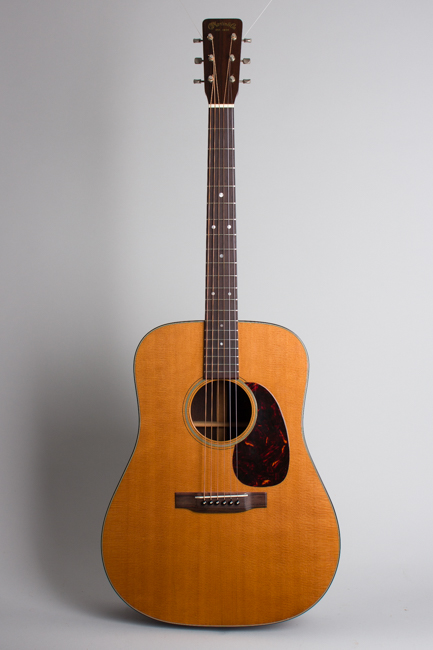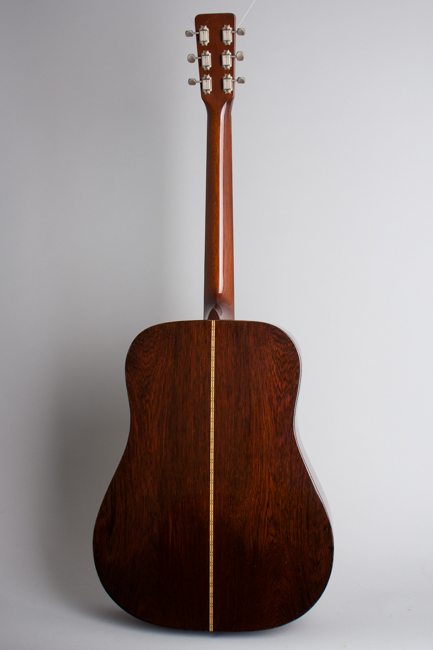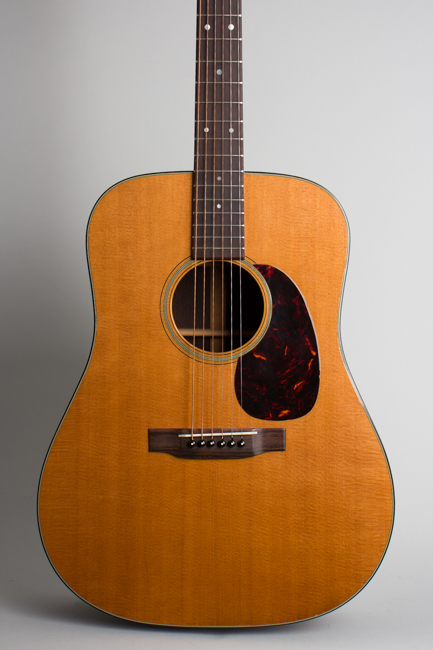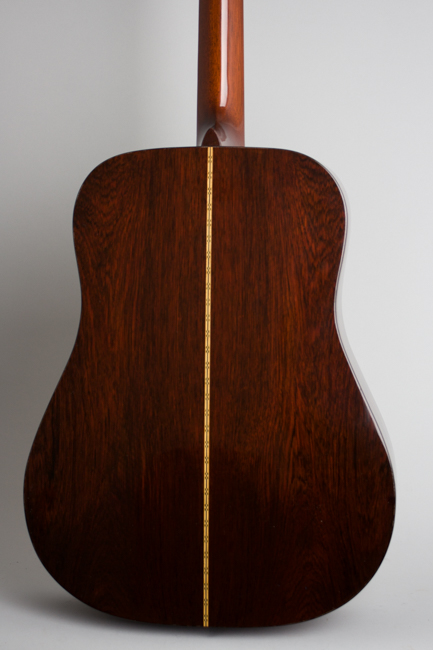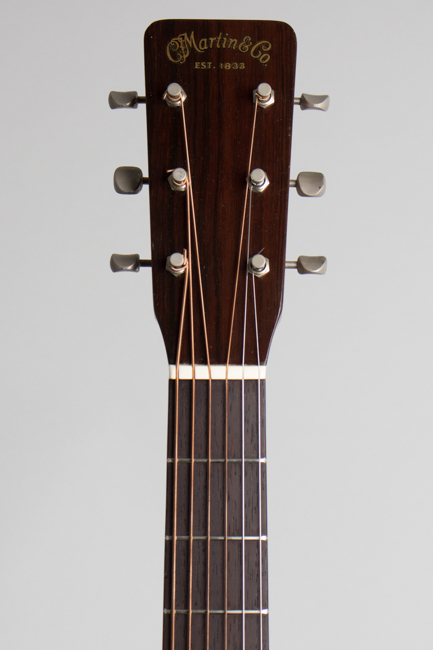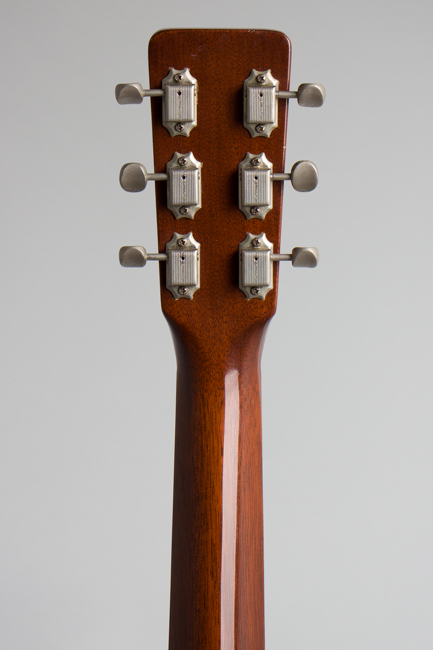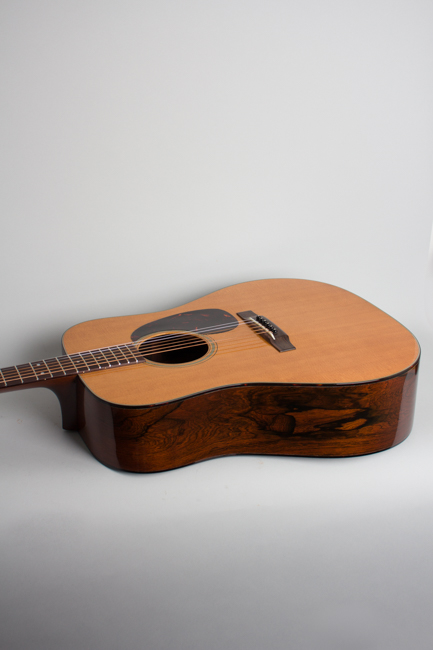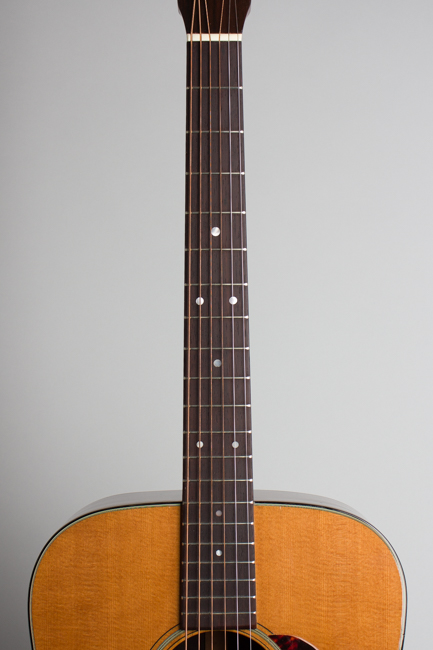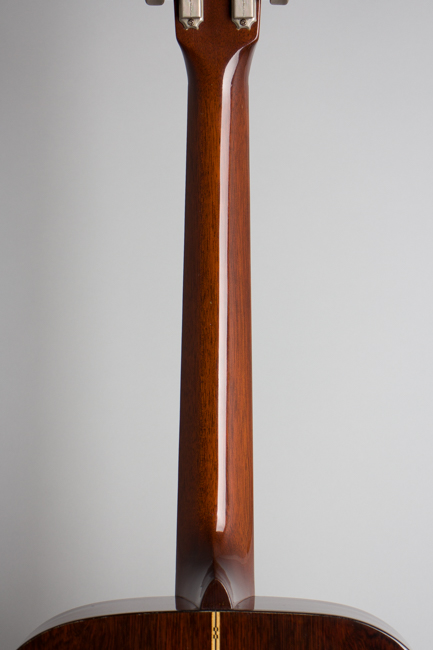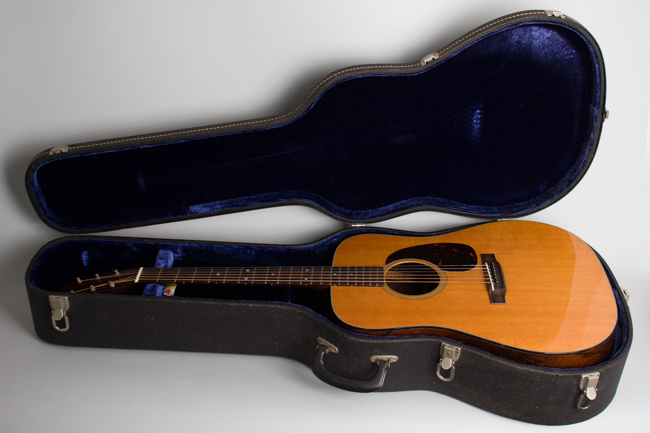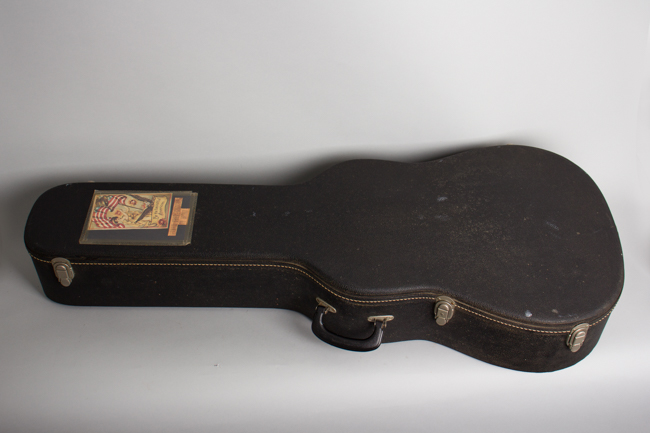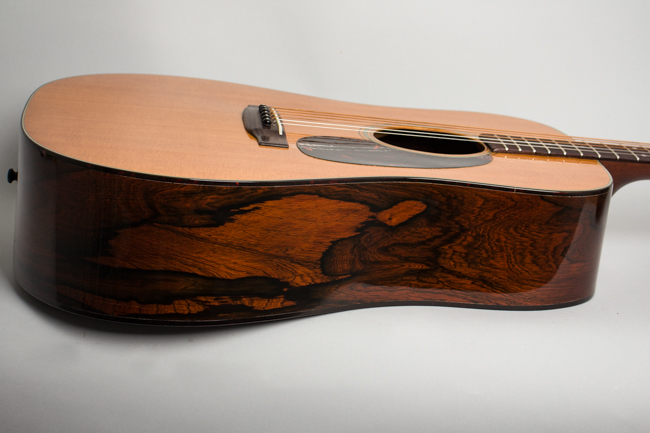C. F. Martin D-21 Flat Top Acoustic Guitar (1961)
This item has been sold.
Item # 10679
Prices subject to change without notice.
C. F. Martin D-21 Model Flat Top Acoustic Guitar (1961), made in Nazareth, PA, serial # 180292, natural lacquer finish, Brazilian rosewood back and sides, spruce top; rosewood fingerboard and bridge, original black tolex hard shell case.
All we can say on this one is; Wow, it's a fantastic-sounding, clean early-1960s Martin D-21. As our Uncle Buck used to say, "What's not to like?"
The D-21 may be Martin's most overlooked guitar, some of the rarest 1960's Dreadnoughts. It basically combines the plainer Style-18 cosmetics with the Brazilian rosewood body of the then top-of-the-line D-28. Although at $215 in mid-1961 it was a full $120 less expensive, only 100 D-21s were produced that year compared to over five times that number of D-28's. Apparently regarded as neither fish nor fowl among Dreadnought customers, the D-21 languished despite (reportedly) being C.F. Martin III's personal favorite model. He was known to prefer the understated elegance if shaker aesthetics, and considered the white-bound D-28 overly gaudy!
This is a lovely 1961 example, still the product of the older Martin factory and for all practical identical to 1950s models. The nicely aged ambered spruce top has a tortoise shell celluloid pickguard and binding, with the old long-saddle rosewood bridge. The bridge plate is still the traditional small maple piece, which Martin would change in the later 1960s by substituting a big block of rosewood. The Brazilian rosewood back has a fairly even grain that Martin preferred with a bit of figuring and a chain-pattern backstrip. The sides have some truly spectacular almost 3-D light-and-dark grain figure, very rare for a Martin of this period and something the company's wood pickers usually frowned on at the time, hence its use on the lower priced Style 21!
The unbound rosewood fretboard has pearl dot markers. The headstock shows the rounded-corners typical of this era (when Martin's shaping templates having become very worn from use) and carries original Kluson Deluxe tuners. Built in Martin's then-overstretched and cramped original factory this guitar retains the older handmade feel that would increasingly become obscured as the decade progressed.
Some old guitar hounds insist that the D-21 is actually the best-sounding of all postwar Dreadnoughts; something about the combination of the rosewood body and the narrower binding channel at the edge of the top. Fact or voodoo? We're not sure, but we have encountered some really splendid examples of this model -- here's another one!
Overall length is 40 1/2 in. (102.9 cm.), 15 1/4 in. (38.7 cm.) wide at lower bout, and 4 3/4 in. (12.1 cm.) in depth at side, taken at the end block. Scale length is 25 1/2 in. (648 mm.). Width of nut is 1 5/8 in. (41 mm.).
This D-21 is a clean example, showing some older work but very little in the way of wear. The finish has only a few very small dings, dents and scrapes but hardly any play wear, pretty much completely free of the common pick scratches. The finish may have been polished out, but does not appear oversprayed, just touched up a bit mostly around the heel. The neck has a very slim feel; it appears the fingerboard was planed and refretted with correct Martin-style wire at some point. The rosewood fingerboard is a bit thinner than it likely was originally, but the neck is dead straight and playability is excellent.
The Other notable repairs include a carefully regued pickguard; most likely, it peeled up under the "B" string and was carefully flattened and re-attached in that area. The bridge may have been reglued as well, but again it is a very clean job. The neck has been reset but it is also such a clean job there is very little evidence, except what is visible under black light. The bridge is original, the saddle is a carefully made bone replacement.
This guitar is an excellent player with a big chunky sound; as noted the slight thinning of the fingerboard helps give the neck a very fast feel. This is a very inviting guitar to play and we feel think some serious play time would bring out its sonic qualities even more; it simply does not appear to have been used that much in 60+ years. It is housed in a period blue-lined Victoria HSC that appears to have been with the guitar forever. Overall Excellent Condition.
All we can say on this one is; Wow, it's a fantastic-sounding, clean early-1960s Martin D-21. As our Uncle Buck used to say, "What's not to like?"
The D-21 may be Martin's most overlooked guitar, some of the rarest 1960's Dreadnoughts. It basically combines the plainer Style-18 cosmetics with the Brazilian rosewood body of the then top-of-the-line D-28. Although at $215 in mid-1961 it was a full $120 less expensive, only 100 D-21s were produced that year compared to over five times that number of D-28's. Apparently regarded as neither fish nor fowl among Dreadnought customers, the D-21 languished despite (reportedly) being C.F. Martin III's personal favorite model. He was known to prefer the understated elegance if shaker aesthetics, and considered the white-bound D-28 overly gaudy!
This is a lovely 1961 example, still the product of the older Martin factory and for all practical identical to 1950s models. The nicely aged ambered spruce top has a tortoise shell celluloid pickguard and binding, with the old long-saddle rosewood bridge. The bridge plate is still the traditional small maple piece, which Martin would change in the later 1960s by substituting a big block of rosewood. The Brazilian rosewood back has a fairly even grain that Martin preferred with a bit of figuring and a chain-pattern backstrip. The sides have some truly spectacular almost 3-D light-and-dark grain figure, very rare for a Martin of this period and something the company's wood pickers usually frowned on at the time, hence its use on the lower priced Style 21!
The unbound rosewood fretboard has pearl dot markers. The headstock shows the rounded-corners typical of this era (when Martin's shaping templates having become very worn from use) and carries original Kluson Deluxe tuners. Built in Martin's then-overstretched and cramped original factory this guitar retains the older handmade feel that would increasingly become obscured as the decade progressed.
Some old guitar hounds insist that the D-21 is actually the best-sounding of all postwar Dreadnoughts; something about the combination of the rosewood body and the narrower binding channel at the edge of the top. Fact or voodoo? We're not sure, but we have encountered some really splendid examples of this model -- here's another one!
Overall length is 40 1/2 in. (102.9 cm.), 15 1/4 in. (38.7 cm.) wide at lower bout, and 4 3/4 in. (12.1 cm.) in depth at side, taken at the end block. Scale length is 25 1/2 in. (648 mm.). Width of nut is 1 5/8 in. (41 mm.).
This D-21 is a clean example, showing some older work but very little in the way of wear. The finish has only a few very small dings, dents and scrapes but hardly any play wear, pretty much completely free of the common pick scratches. The finish may have been polished out, but does not appear oversprayed, just touched up a bit mostly around the heel. The neck has a very slim feel; it appears the fingerboard was planed and refretted with correct Martin-style wire at some point. The rosewood fingerboard is a bit thinner than it likely was originally, but the neck is dead straight and playability is excellent.
The Other notable repairs include a carefully regued pickguard; most likely, it peeled up under the "B" string and was carefully flattened and re-attached in that area. The bridge may have been reglued as well, but again it is a very clean job. The neck has been reset but it is also such a clean job there is very little evidence, except what is visible under black light. The bridge is original, the saddle is a carefully made bone replacement.
This guitar is an excellent player with a big chunky sound; as noted the slight thinning of the fingerboard helps give the neck a very fast feel. This is a very inviting guitar to play and we feel think some serious play time would bring out its sonic qualities even more; it simply does not appear to have been used that much in 60+ years. It is housed in a period blue-lined Victoria HSC that appears to have been with the guitar forever. Overall Excellent Condition.
